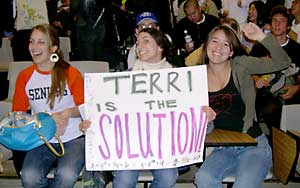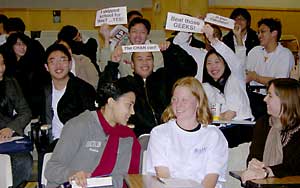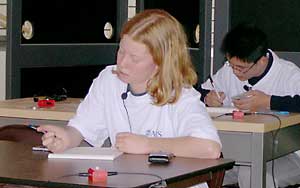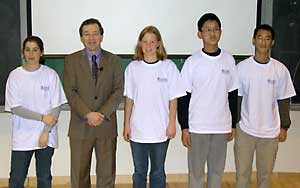
Who Wants to Be a Mathematician in California
 |
Sixteen students from the San Francisco Bay area played Who Wants to Be a Mathematician on April 4 and 5. Eight of the students played at San Francisco State University on April 4 and eight played the next day at the Mathematical Sciences Research Institute (MSRI) in Berkeley. The winners of those games at the two sites played a championship game at MSRI on the 5th. Each day the games were preceded by a mathematics talk. Summaries of the talks and the games are below.
Who Wants to Be a Mathematician at San Francisco State University
Who Wants to Be a Mathematician at the Mathematical Sciences Research Institute
The Mathematics and Logic of the Sudoku Puzzle by Tom Davis
 |
In front of a packed house, Tom Davis talked about Sudoku puzzles, giving the puzzle rules and strategies for their solution. He introduced several terms - virtual lines, naked pairs, hidden triples, X-wings and swordfish - that describe situations encountered in the puzzles. He also talked about using coloring to identify possibilities that are associated (for example, "If a 1 goes here, then a 1 also must go here") or complementary ("If a 1 goes here, then a 7 must go here"). Davis showed how a string of these possibilities can be taken together, and used logically to deduce conclusions, so that a candidate value for a square and the set of squares associated with it can be determined. He pointed out that this is the transitive closure of the possibilities. The text of Davis's talk which has many more facts about Sudoku is online.
 |
Who Wants to Be a Mathematician
After some snacks and refreshments, students from the West San Francisco Bay area played two games of Who Wants to Be a Mathematician.
|
Pictured here are the students (left to right) practicing for game one (at the time, Jackie Koo was filling in for Jamie Brett of Maria Carillo High School): Terri Hoberg, Santa Rosa High School Jackie Koo, Notre Dame High School Louis Ng, Abraham Lincoln High School Daniel Chan, Burton High School |
 |
|
Here are the students (left to right) playing game two : Xiao Xu, Balboa High School Amarsanaa Bat Ochir, Wallenberg High School Joy Zhang, Carlmont High School Jackie Koo, Notre Dame High School |
 |
The audience was both very enthusiastic - with rousing welcomes for the contestants - and well-behaved - becoming very still while the contestants were working on questions.
 |
 |
Terri Hoberg won game one and Xiao Xu won game two. The two then got their chance at the bonus question, worth $1500. Both selected the same choice, which the audience also preferred. Unfortunately it was an incorrect choice, so neither won the cash prize, but they both won TI-89 Titanium graphing calculators and the right to compete in the championship game at MSRI the next day. Louis Ng gave an excellent explanation of how to solve the bonus question.
 |
Here are the prizes won by the students in the competition at San Francisco State University:
- TI-89 Titanium graphing calculator from Texas Instruments: Terri Hoberg and Xiao Xu
- Maple 10 from Maplesoft: Louis Ng and Joy Zhang
- Calculus by Anton, Bivens and Davis from John Wiley and Sons: Jamie Brett and Jackie Koo
- What's Happening in the Mathematical Sciences by Barry Cipra from the AMS: Daniel Chan and Amarsanaa Bat Ochir
Who Wants to Be a Mathematician at the Mathematical Sciences Research Institute (MSRI)
 |
 |
David Eisenbud, MSRI Director, talked about MSRI's hosting of research seminars and public programs, and introduced the speaker, Vaughan Jones, Fields Medalist and Honorary Vice President for Life of the International Guild of Knot Tiers.
 |
What's a Knot? by Vaughan Jones (University of California, Berkeley)
Jones defined the term knot and told the audience that knots appear in clothes and that they have been used as long as numbers have. He showed the unknot (like a circle) and the trefoil (the second drawing on the blackboard above). The two look different, but are they? Is there a transformation, short of cutting, that will transform one into the other? Jones did several things to his trefoil, including draping it over himself and stepping through it, which did not change the knot, but how to prove that all such actions wouldn't transform the trefoil into the unknot?
He then explained how knots arose in the study of electromagnetism and chemistry (Lord Kelvin thought that atoms were knots in the ether, so studying knots was thought to be important to explaining chemical properties). Today knots are important in the study of DNA, which is knotted. Jones told of the time a molecular biologist got in touch with a mathematician who "solved 90% of his problems overnight."
Who Wants to Be a Mathematician
Eight East Bay Area students played two games of Who Wants to Be a Mathematician, not only for prizes and a chance at the $1500 bonus question, but also for a chance to play in the championship game.
One of the qualifying contestants in game one did not show up, so volunteers from the audience were recruited to answer a play-in question and earn a place in the game. Aaron Szasz earned the chance to play by being the first to answer the question correctly. Stav Braun, a classmate of Aaron's, won game one.
Game two was a tight contest that wound up in a tie between Xingfu Liang and Jay Wang. Wang won the tie-breaker, which put him into the bonus round with Stav and into the championship game with Stav, Terri and Xiao. Stav - and much of the audience - answered the bonus question about complex roots of unity correctly and earned $1500.
 |
The prizes won by the eight contestants at MSRI are:
- TI-89 Titanium graphing calculator from Texas Instruments: Stav Braun (Santa Cruz High School) and Jay Wang (Foothill High School)
- Maple 10 from Maplesoft: Aaron Szasz (Santa Cruz) and Xingfu Liang (Piedmont High School)
- Calculus by Anton, Bivens and Davis from John Wiley and Sons: Di Di (Davis Senior High) and Frederick Wang (Arroyo High School)
- What's Happening in the Mathematical Sciences by Barry Cipra from the AMS: Bonnie Jin (Foothill) and Matt Smith (Valley Christian High School)
Championship Game
 |
In the championship game, all the prizes were cash, offered by the AMS. The "Battle of the Bay" was also very close and, like game two, wound up in a tie, this time between the two winners from the previous day, Terri Hoberg and Xiao Xu. Judge Bill Butterworth of DePaul University and host Mike Breen of the AMS decided to let both students enter the bonus round. Xiao told the audience that he was going to donate some of his winnings to poor children.
 |
Even though there were two students in the championship bonus round, the AMS bank was not broken as unfortunately neither contestant got the very difficult question correct. Winnings from the championship game:
- Terri Hoberg and Xiao Xu: $1250 (each)
- Stav Braun and Jay Wang: $500 (each)
 |
All the students appreciated the prizes and cash, but the best prize may have been the pizza provided after the games by MSRI.
Thanks to David Meredith, chair of the San Francisco State University Department of Mathematics, and David Eisenbud for hosting the games. Thanks also to game sponsors Texas Instruments, Maplesoft, and John Wiley and Sons, and to the contestants' teachers for participating and arranging for their students to come to the lectures and games. Finally, a hearty congratulations to the Sweet Sixteen who played in the Bay Area games!
Photographs by Bill Butterworth, DePaul University Department of Mathematical Sciences.

